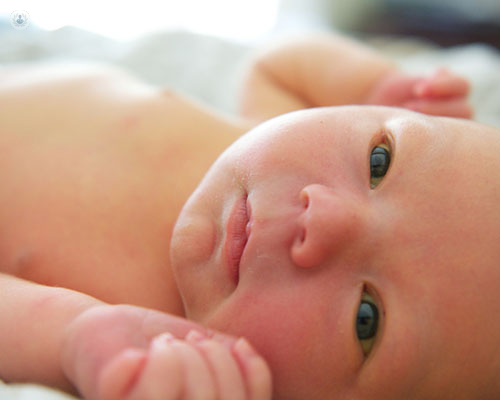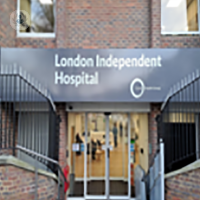What is a hydrocele?
A hydrocele is a swelling of fluid, most commonly occuring in the scrotum between the thin layer of tissue surrounding the testes. These can be common in newborns, but also occur in older boys and men following injury to or inflammation of the scrotum. Generally, a hydrocele is not painful and may not need treatment, but it is always a good idea to visit a doctor.

Prognosis
It is not a serious condition, and in newborns and children, a hydrocele will usually go away without treatment over time. On the other hand, in adults, surgery is usually required, but it is a simple procedure with very good results. If pain is experienced alongside a hydrocele, see a doctor as soon as possible.
Symptoms of a hydrocele
The key feature of a hydrocele is a swelling of fluid near the testicles. There is usually no pain experienced. They can occur on either side of the testicles, and can cause some discomfort for adults if the swelling increases in size.
How is a hydrocele diagnosed?
A doctor would first need to perform a full physical examination, checking the scrotum and the extent of the swelling. They will also check to see if the swelling is painful to the touch. Lastly, they would need to double check for an inguinal hernia, which may be done via ultrasound. It is also common to illuminate a light through the scrotum, as the transillumination indicates the presence of transparent fluids in the area of the testicle. Blood tests may be done to rule out an infection.
What are the causes of a hydrocele?
Hydroceles are common in newborns. This is because during the development of a baby in the uterus, the testicles descend from the abdomen through a duct to the scrotum. If the duct is not closed, it causes hydroceles, as the fluid drains and becomes trapped in the scrotum, causing swelling.
In older males, hydroceles can occur due to an accumulation of fluids around the testicle area. This could be caused by an overproduction of fluid by the body, due to injury or infection.
Can hydroceles be prevented?
Hydroceles cannot be prevented in babies. It is important to visit a specialist regularly if a hydrocele is found after birth.
Treatments for hydroceles
As mentioned before, hydroceles usually disappear by themselves in male babies. If a hydrocele does not go away on its own in adults, surgery may be required to remove it. This surgery can be performed using general or local anaesthesia. The procedure involves making an incision in the scrotum or lower abdomen to remove the hydrocele. After surgery, a tube may be placed to drain the fluid, as well as dressing the area with a bandage for a few days.
Hydroceles may reappear after surgery, which is why it is important to follow up with the doctor a while after the procedure.
What specialist treats hydroceles?
In babies, hydroceles should be treated by a specialist in paediatric surgery, and in adults by a specialist in urology.
11-13-2012 05-19-2023Hydrocele
What is a hydrocele?
A hydrocele is a swelling of fluid, most commonly occuring in the scrotum between the thin layer of tissue surrounding the testes. These can be common in newborns, but also occur in older boys and men following injury to or inflammation of the scrotum. Generally, a hydrocele is not painful and may not need treatment, but it is always a good idea to visit a doctor.

Prognosis
It is not a serious condition, and in newborns and children, a hydrocele will usually go away without treatment over time. On the other hand, in adults, surgery is usually required, but it is a simple procedure with very good results. If pain is experienced alongside a hydrocele, see a doctor as soon as possible.
Symptoms of a hydrocele
The key feature of a hydrocele is a swelling of fluid near the testicles. There is usually no pain experienced. They can occur on either side of the testicles, and can cause some discomfort for adults if the swelling increases in size.
How is a hydrocele diagnosed?
A doctor would first need to perform a full physical examination, checking the scrotum and the extent of the swelling. They will also check to see if the swelling is painful to the touch. Lastly, they would need to double check for an inguinal hernia, which may be done via ultrasound. It is also common to illuminate a light through the scrotum, as the transillumination indicates the presence of transparent fluids in the area of the testicle. Blood tests may be done to rule out an infection.
What are the causes of a hydrocele?
Hydroceles are common in newborns. This is because during the development of a baby in the uterus, the testicles descend from the abdomen through a duct to the scrotum. If the duct is not closed, it causes hydroceles, as the fluid drains and becomes trapped in the scrotum, causing swelling.
In older males, hydroceles can occur due to an accumulation of fluids around the testicle area. This could be caused by an overproduction of fluid by the body, due to injury or infection.
Can hydroceles be prevented?
Hydroceles cannot be prevented in babies. It is important to visit a specialist regularly if a hydrocele is found after birth.
Treatments for hydroceles
As mentioned before, hydroceles usually disappear by themselves in male babies. If a hydrocele does not go away on its own in adults, surgery may be required to remove it. This surgery can be performed using general or local anaesthesia. The procedure involves making an incision in the scrotum or lower abdomen to remove the hydrocele. After surgery, a tube may be placed to drain the fluid, as well as dressing the area with a bandage for a few days.
Hydroceles may reappear after surgery, which is why it is important to follow up with the doctor a while after the procedure.
What specialist treats hydroceles?
In babies, hydroceles should be treated by a specialist in paediatric surgery, and in adults by a specialist in urology.


Hydrocele in adults: is excess fluid in the scrotum dangerous?
By Professor Francis Chinegwundoh MBE
2024-12-14
Hydrocele presents as swelling in the scrotum because of excess fluid in the lining of the sack. We asked one of our leading urologists Professor Francis Chinegwundoh MBE whether this is a dangerous condition and what kind of treatment may be required. See more


Identifying scrotal swellings: Hydroceles in babies
By Mr Nav Johal
2024-12-14
In baby boys, testicles descend down into the scrotum before birth. It is in this moment that a hydrocele, a fluid build-up that swells, may form within the baby’s scrotum. Mr Nav Johal, leading consultant paediatric urologist, explains more. See more


Scrotal swelling in children: what are the causes?
By Miss Marie-Klaire Farrugia
2024-12-14
Scrotal swelling may be painless or it can be rather painful and some cases require immediate treatment as soon as hours after symptoms become present. Miss Marie-Klaire Farrugia, a leading paediatric urologist and expert in treating children's scrotal swelling, explains the causes and swift action needed to have the swelling assessed, diagnosed and treated. See more


Types of hydrocele
By Mr Andrew Robb
2024-12-14
It is always worrying when something is wrong with our children, but it can be a particular concern when the condition affects their genitals. Swollen testicles can indicate the presence of a hydrocele. But what is this condition and how does it happen? Esteemed paediatric urologist Mr Andrew Robb explains. See more
Experts in Hydrocele
-
Professor Francis Chinegwundoh MBE
UrologyExpert in:
- Prostate cancer
- Benign prostate enlargement
- Medicolegal
- Hydrocele
- Erectile dysfunction
- Vasectomy
-
Mr Andrew Robb
Paediatric urologyExpert in:
- Urinary incontinence
- Paediatric urology
- Urinary tract infection
- Circumcision
- Vesicoureteral reflux (VUR) (kidney reflux)
- Hydrocele
-
-
Mr Dan Higman
Paediatric surgeryExpert in:
- Nail diseases
- Circumcision
- Undescended testicle (Cryptorchidism)
- Hydrocele
- Umbilical hernia
- Hernia
-
Mr Omar Al Kadhi
UrologyExpert in:
- Bladder cancer
- Prostate cancer
- Haematuria (blood in the urine)
- Prostate MRI
- Urinary tract infection
- Hydrocele
- See all

The London Independent Hospital - part of Circle Health Group
The London Independent Hospital - part of Circle Health Group
1 Beaumont Square, Stepney Green
No existe teléfono en el centro.
By using the telephone number provided by TOP DOCTORS, you automatically agree to let us use your phone number for statistical and commercial purposes. For further information, read our Privacy Policy
Top Doctors

London Bridge Hospital - part of HCA Healthcare
London Bridge Hospital - part of HCA Healthcare
27 Tooley St
No existe teléfono en el centro.
By using the telephone number provided by TOP DOCTORS, you automatically agree to let us use your phone number for statistical and commercial purposes. For further information, read our Privacy Policy
Top Doctors

Guy’s and St Thomas’ Private Healthcare
Guy’s and St Thomas’ Private Healthcare
Guy’s Hospital, Great Maze Pond
No existe teléfono en el centro.
By using the telephone number provided by TOP DOCTORS, you automatically agree to let us use your phone number for statistical and commercial purposes. For further information, read our Privacy Policy
Top Doctors
-
The London Independent Hospital - part of Circle Health Group
1 Beaumont Square, Stepney Green, East LondonExpert in:
- Cataracts
- Bariatric Surgery
- Maxillofacial Surgery
- Neurological spinal surgery
- Orthopaedic surgery
- Orthopaedic spinal surgery
-
London Bridge Hospital - part of HCA Healthcare
27 Tooley St, Central LondonExpert in:
- 24-hour service
- Cardiology
- Minimal access surgery (keyhole surgery)
- Orthopaedic surgery
- Cardiovascular disease
- Gastroenterology
-
Guy’s and St Thomas’ Private Healthcare
Guy’s Hospital, Great Maze Pond, SE1 South Bank LondonExpert in:
- Allergy
- Cardiology
- General Surgery
- Maxillofacial Surgery
- Thoracic Surgery
- Maternity care
- Most viewed diseases, medical tests, and treatments
- Fertility preservation
- Female infertility
- Undescended testicle (Cryptorchidism)
- Testicular ultrasound
- Abdominal pain
- Minimal access surgery (keyhole surgery)
- NanoKnife
- Vaginal dryness
- Pelvic pain syndrome
- Kidney stones







